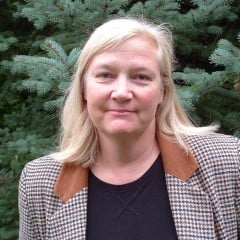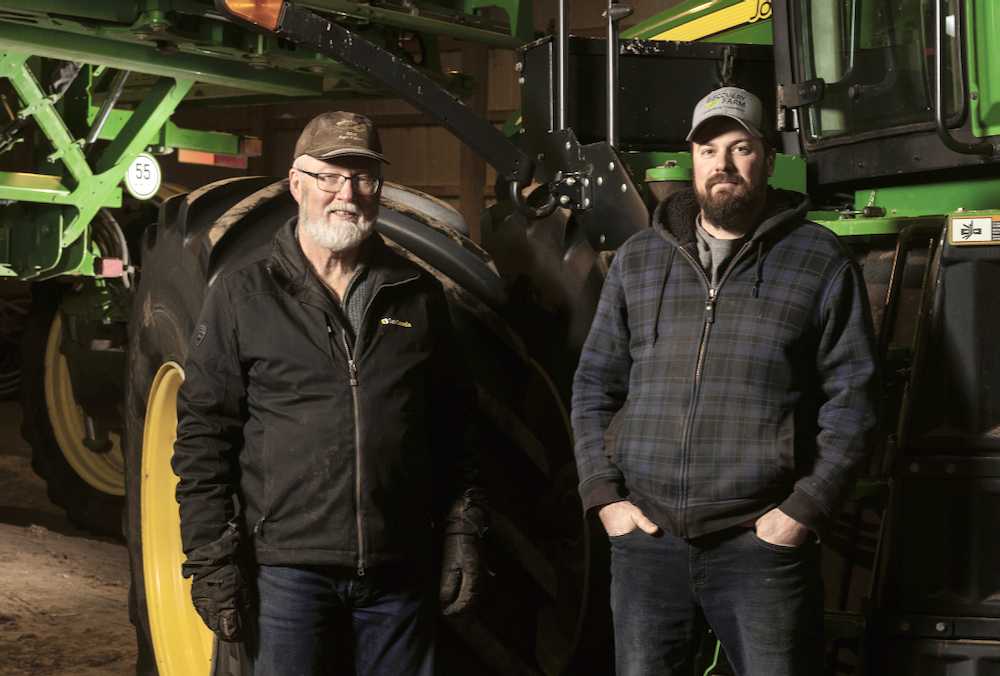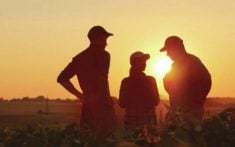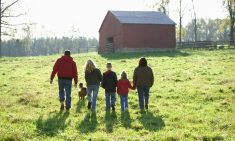[UPDATED: Mar. 22, 2022] Doyle Wiebe expects to do a lot more golfing this summer than he did eight years ago, and he’s managing to find time for a lot of other activities too, like mentoring and consulting, that he much prefers over driving a tractor for hours at a time.
In 2014, by contrast, he was still in his quandary. He knew he wanted to step back from actively farming his 4,000-acre farm near Langham, a half hour north of Saskatoon, and he also knew that he wanted, somehow, to preserve the legacy of the grain farm that he and his father had built up over the previous 50 years.
But his children were both pursuing careers off the farm, and he had no one on hand to take over the business.
Read Also

Farmland values: assumptions and realities
Where farmland values are headed and what decisions farmers should make
Down his road, meanwhile, a young man named Mark Thompson had just moved into the neighbourhood, and he had a quandary of his own. Thompson was trying to make his own start at farming. He knew what he had to do. He was ambitious. But it looked like a very steep hill.
In time, inevitably, the pair met. Then the idea took hold. Why not find a way to work together so each could achieve what they wanted?
Could they be that flexible, adaptable and innovative?
- Read more: Their joint venture
The search begins
Actually, history was on their side. When Wiebe had been ready to start his own farm career in the 1970s, there were some wrinkles that he and his father explored with a provincial government farm management specialist. Wiebe’s father didn’t want to quit farming immediately, and Wiebe had a life he wanted to live, including travel. He wasn’t ready to pledge everything to the farm.
So the specialist suggested a joint venture. They didn’t call it that, just “the working agreement,” but the concept saw them through the next 20 years until Wiebe finally bought his father’s remaining equity in 1996. (The agreement is outlined below. Also see the upcoming March 1 edition of Country Guide for more technical insights into joint ventures.)
That’s how it turned out that, in 2014, when Mark and Kristin Thompson moved with their first child onto a yard site just down the road and were renting some land, Wiebe had an idea to put on the table.
As with Wiebe and his father, this new arrangement would be based on linking their goals. Wiebe needed a successor. Thompson needed to invest in his future.
But there was also a first step. They had to be sure they could be a good fit, so they agreed to work together informally for a year, even though this would mean Thompson would have to quit his full-time job at the University of Saskatchewan.
They did click, though, and yes, it looked like they could work together in a more serious way, which meant turning their attention to the big job. How could they formulate a joint venture plan, and how would they organize the real-life running of the farm in a way that would work for both?
One of the most important decisions was also one of the earliest.
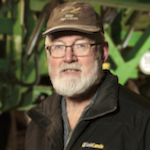
“The model we came up with divided management responsibilities right off the hop,” Wiebe says. “Mark took on the tasks that I never felt that great doing anyway, which was the agronomy, equipment maintenance and the human resources part.”
And they also focused on one of Thompson’s big objectives. “It took a lot of risk off the table,” Thompson says of the agreement. “I wasn’t asked to find a million dollars so I could buy my way in.”
“Basically, we took Doyle’s last year’s inventory and that became an operating loan into the joint venture on the books that we had to pay back to him. It wasn’t fixed, so when we had bad years, we didn’t pay as much back, and when we had good years, we paid more than we had planned on.”
Flexibility turned out to be a good thing because the joint venture’s first crop year turned out to be one of the worst in a decade.
“If I had jumped into (the farm) on my own,” a relieved Thompson soon realized, “I would have had a hard time paying the bills that year.”
Today, Wiebe’s main labour contribution to the farm operation is on the financial management side of things. He does all the bookkeeping and most of the financial planning work, although he’s slowly sharing this part of the business and the financial decision-making with Thompson, so he can eventually take that over too.
The exceptional idea
“It’s still not very high on the priority list of consultants and advisors,” Wiebe says of joint ventures. “They still mostly deal with corporate share structures to try to mitigate tax implications, give shares away and do different things.”
That means, he says, that the incoming farmer, whether family or not, gets locked into something they have probably not helped build and may not fully understand or value the operational logistics of.
By contrast, with a joint venture, each party is continually looking at what they can contribute and how to make the business successful. It also means that by making it successful, they are making progress with their own short- and long-term goals.
“It has a much better management training aspect to it,” Wiebe says. “You are looking at how every decision impacts your own income and the overall profitability of the farm in total.”
Much of the benefit comes down to the contributions approach that characterizes a joint venture. Contributions for each participant are calculated so they are responsible for a pre-agreed percentage of the expenses and also receive the same percentage of the revenues, which means they assume a certain amount of risk.
These revenues and expenses are recorded and reported separately, for tax purposes, by each of the participants.
Wiebe and his father had found the contributions approach worked well for them over the 23 years they farmed together, because it is flexible enough to allow for one party’s contributions of labour and investment to fluctuate as their level of involvement in actual farming activities vary over the years.
“There’s no firm number that you have to equal,” Wiebe says. “I left the country for three years in the middle of our 20-year agreement and my dad was supportive of that. He carried on farming and my labour contribution came out. When I came back to farm, it went back in again. While I was gone, the proportion of the profit margins that I still was owed made my land payments, so it was fine.”
The basics of making it work
Wiebe and Thompson use a fairly simple spreadsheet to flesh out their annual contributions of the joint venture. There are two columns, one for each party, listing the contributions they make in three categories: labour, investment (which includes land, building and equipment) and depreciation.
Contributions of labour are valued at a dollar figure, but investments in land, equipment and buildings have an annual contribution value based on what the parties agree is a reasonable return on investment, for example a set per cent for depreciable assets. (Land is calculated off local cash rental rates. Depreciation rates are 12 per cent on all equipment and five per cent on buildings.)
Then, based on their percentage of contributions, each party is allocated a percentage of the farm’s revenue and expenses, with all these values reviewed and reassessed, if needed, annually.
An extra benefit, Wiebe says, is that the system shines a light on all the components of cost of production. “Not only does the calculation of all of our contributions help us see what our total costs are, but our returns are relative to our costs, and by doing the calculations each year we can look at, for example, if one of us does buy land or a tractor, how is it going to change our percentage of the income? The spreadsheet tells you right away.”
It also helps cash-flow forecasting, which Wiebe calls a key element of what makes them sustainable, especially as they tie it in with their marketing program so it helps them evaluate opportunities to make improvements and changes.
To make it work, though, both Wiebe and Thompson say it’s essential to understand depreciation and be comfortable including it in the agreement’s financial planning.
Another ingredient is essential too. Even though Wiebe and Thompson maintain their own separate farming corporations with their own books, they look at the farm as a whole, which solves all kinds of issues that other business structures can cause and lets them take advantage of opportunities because they are always looking ahead.
“Over time, you have to align yourself, you can’t be completely offside,” Wiebe says. “You agree on what’s going to be seeded and where, and you don’t have to worry about seeding or harvesting his field or my field first because it’s all part of the big plan.
“It’s more of a marriage in that sense. In my experience, I often saw families torn apart later because how do you change that family relationship of sharing equipment when there is more investment in equipment needed? How do you fairly split assets, or inventory or production when the proportions of the different types of asset classes are owned differently, and there’s no formula for it in a lot of cases. The joint venture provides a formula for that.”
Getting started
Thompson and Wiebe start the process of determining the contributions by pencilling in what they have to contribute. In the first, trial year of their joint venture, Thompson’s primary contribution was labour, and Wiebe’s was cash flowing the working capital.
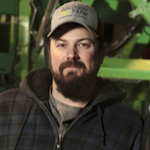
“The way we set it up is that labour is valued quite highly, so that allowed me to build because I could put a lot of labour into it even though I didn’t have a lot of investment into the farm yet,” Thompson says.
“That allowed me to make some more money, and although it was slow at the start, as I have gained more equity over the years I have bought and paid off some equipment and was able to buy some land,” he says, adding “We paid Doyle’s loan off a few years ago, and that gives us more power to invest and put ourselves in a better financial situation with the farm.”
Because Thompson was contributing the value of his labour to the venture, in the interim, he needed another source of income, which luckily, he could provide through the family’s off-farm sources, which includes some rental properties and his wife Kristin’s career as an architect.
“One of the key factors with Mark and his wife was that that they were willing to sacrifice a bit of their own personal income to put into something like this,” Wiebe says. “They are both business-oriented people and understand that you have to build up equity … It was a big factor that Mark was able to plough almost every bit of earnings back into the farm, whether as debt payments or purchases if the cash was there.”
The percentages have gradually changed as they continue to work together and Thompson has built equity and has been able to help grow the farm to around 6,500 acres by renting and purchasing more land. Meanwhile, Wiebe continues to contribute his assets like land and equipment, and provide some of the working capital as needed, but has reduced his labour to pursue more off-farm activities.
“The flexibility to change the proportions within a joint venture every year is something that people won’t maybe understand,” Wiebe says. “Each year you redo the addendum to the agreement to sign off on how you are splitting things this year, and next year it’s going to be a little bit different. The pendulum moves, that’s the nature of it.”
Making the relationship click
While flexibility and commitment were key factors for both Wiebe and Thompson, another was being open to compromise and new ideas.
“Although we hadn’t talked about it that much before we signed on the line, he wanted to grow the farm more,” Wiebe says. “For sure he was right, that if he could grow it a little bit more than the initial size with his extra rented land to make two combines worthwhile and that kind thing, he’d be able to build equity a lot faster, and that’s what happened.”
Thompson sees it like that too. “We haven’t butted heads a lot because Doyle is easygoing and willing to let me try new things,” he says. “I think part of the success of our relationship, too, is because Doyle came to me, ready to transition the farm. It wasn’t me trying to convince him that it was time to retire. When you talk to a lot of people, the parent is still farming when they’re 70 or 80 years old and they haven’t given up a lot of control. Whereas Doyle, he’s happy to step back and whenever I’ve got questions, he’s ready to sit down and discuss them.”
Although the end game for Doyle and Thompson is ultimately to transition the farm, neither is in a rush for Thompson to take complete ownership.
“We sit down every year and talk about where we think we’re going with the farm and go through a bunch of numbers,” Thompson says. “Part of that discussion every year is what Doyle’s labour commitment is going to be that year. He’s to the point now, where doing the labour aspect of it is not high on his priority list, but if I need a hand, he’ll come out and help, but he’s still got a lot of investment in the farm with land, equipment and buildings that is not a huge priority to transfer out.”
Their initial plan projected that they would work together and gradually transition the farm over 10 years, but even that is not set in stone, because it’s the success of the transition that is more important to them both than the time frame.
“We didn’t set it up to say after 10 years, make sure I can pull the pin and that you’re ready to take it all,” Wiebe says. “It was a 10-year planning horizon and we may carry on for another 10 years.”
“Doyle is ready to retire, but he’s still willing to put into it what is needed to make (the farm transition) succeed,” Thompson says. “It wasn’t like he said, ‘Okay here it is, good luck.’ When we started, he said that in 10 years for the most part, he would like to not be physically working on the farm anymore. But, things change, and his willingness and desire to see the end game, to see this transition that he was ready to do, is probably one of the biggest factors that make this work. We’ve been together long enough now that I think the trust has grown that he can see this succeeding.”
Mentoring comes with the deal
A big aspect of Wiebe and Thompson’s joint venture is the mentoring that has come along with it.
“When I look back at my earlier career with my father, I realize that was a mentoring situation,” Wiebe says. “My father wasn’t long on words, but he was big on lifelong learning, and I would learn from his response to my exuberance about trying new ideas … There were times when I could tell that he was biting his lip more than I was biting mine, but I think he was saying to himself, well if it doesn’t work, we won’t lose the farm, so we might as well try it.”
That same attitude is crucial to making the relationship with Thompson work.
“With Mark, there is mutual respect for both new ideas and for experience,” Wiebe says.
Thompson is the first to acknowledge that he would likely have made some dangerous mistakes if it hadn’t been for Wiebe’s guidance and advice, both in the field and, even more importantly, on the financial and business management end of things.
“That has been huge,” Thompson says. “Just understanding the amount of money that comes and goes through a farm, the planning ahead and managing your cash flow, having your sales throughout certain parts of the year and things like that. I would have probably had a few painful lessons without his advice.”
The value of an open mind
“You don’t know how to evaluate the risk if it’s something new,” Wiebe says of ideas that would change their farm business.
Wiebe had learned a lesson on alternate crops in the ’90’s: “I don’t grow malt barley, I don’t grow certified seed, I don’t grow anything high cost because I have to grow as cheaply as possible and get the most production in a commodity business.”
But Wiebe knew that Thompson had to have that experience for himself, and was willing to let him give the new crops a try. Eventually, they both concluded that only peas made economic sense for their operation, so they dropped the others.
“I had to allow Mark to experience that, and not ever say ‘I told you so,’” Wiebe says.
These days, Thompson consults less with Wiebe on areas that have become his responsibility, which doesn’t bother Wiebe at all. Instead, it’s the road to success, paved with respect for each other.
*Update: The article incorrectly indicated ‘University of Saskatoon’ instead of University of Saskatchewan.

